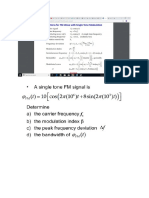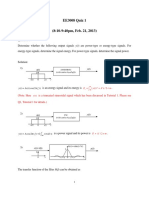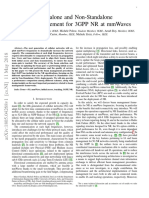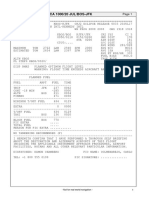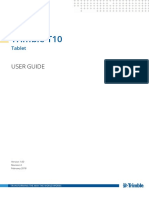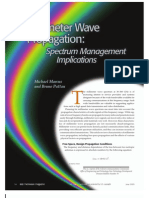0 ratings0% found this document useful (0 votes)
4 viewsAssignment-2
Uploaded by
rahulnaireceCopyright
© © All Rights Reserved
Available Formats
Download as PDF, TXT or read online on Scribd
0 ratings0% found this document useful (0 votes)
4 viewsAssignment-2
Uploaded by
rahulnaireceCopyright
© © All Rights Reserved
Available Formats
Download as PDF, TXT or read online on Scribd
You are on page 1/ 3
ITER, SIKSHA ‘O’ ANUSANDHAN (Deemed to be University) Assignment-2
Branch Electronics and Communication Engineering Program B.Tech
Course Name Communication System-I Semester 5th
Course Code EET-3061 Academic Year 2024/Odd
Assignment- 2 Topic: Fourier analysis and Amplitude Modulation GP-1
Learning Level L1: Remembering L3: Applying L5: Evaluating
(LL) L2: Understanding L4: Analysing L6: Creating
Q’s Questions COs LL
Find the Fourier Transform of the signal given below.
1 CO2 L3
Determine the Fourier Transform of the function f(t)cosω0t.
2 CO2 L3
Let m(t) be a strictly band-limited signal with bandwidth B and energy E.
Assuming ω0=10B, find the energy in the signal m(t)cosω0t.
3 CO2 L3
Gate-2023
2
Find the Fourier Transform x(ω) of 𝑥(𝑡) = 𝑒 −𝑡
4 CO2 L3
Gate-2023
An amplitude modulator has an output (in Volts)
s(t)=A cos(400πt)+B cos(360πt)+B cos(440πt).
The carrier power normalized to 1Ω resistance is 50 Watts. The ratio of the
total sideband power to the total power is 1/9. Calculate the value of B (in
5 Volts, rounded off to two decimal places). CO3 L3
Gate-2024
For a superheterodyne receiver, the intermediate frequency is 15 MHz and the
local oscillator frequency is 3.5 GHz. If the frequency of the received signal
is greater than the local oscillator frequency, then Find the image frequency
(in MHz).
6
Gate-2016 CO3 L3
Consider the signal s(t)=m(t)cos(2πfct)+m’(t)sin(2πfct) where m’(t) denotes
the Hilbert transform of m(t) and the bandwidth of m(t) is very small compared
to f c. Determine, which type of signal the s(t) is.
7 CO3 L4
Gate-2015
Consider an amplitude-modulated (AM) signal
s(t)=Ac cosωct+2 cosωmt cos ωct. For demodulating the signal using an
envelope detector, what should be the minimum value of A c?
8 CO3 L3
Gate-2008
An AM signal is detected using an envelope detector. The carrier frequency
and modulating signal frequency are 1 MHz and 2 kHz respectively. What
9 CO3 L3
should be the appropriate value for the time constant of the envelope detector?
Gate-2004
An AM signal has the form
𝑣(𝑡) = [20 + 2 cos 3000𝜋 𝑡 + 10 cos 6000𝜋 𝑡] cos 2𝜋𝑓𝑐 𝑡
Where 𝑓𝑐 = 10 5Hz
i) Sketch the spectrum of v(t)
10 CO3 L3
ii) Determine the power in each of the frequency component
iii) Determine the modulation index.
iv) Determine the carrier power and side band powers of the AM
signal.
An AM signal is generated by modulating the carrier fc = 800 kHz by the
signal m(t)= sin 2000π t +5 cos 4000π t. The AM signal
V(t)= 100[1+m(t) cos 2 πfct] is fed to a 50-ohm load.
11 i) Determine and sketch the spectrum of the AM signal. CO3 L3
ii) Determine the average power in the carrier and in the sidebands.
iii) What is the modulation index?
iv) What is the peak power delivered to the load?
A DSB-SC signal is modulated by the signal
m(t)=2cos2000π t + cos 6000 π t
The modulated signal is u(t)=100 m(t) cos 2 π f ct, where fc=1 MHz
12 CO3 L3
i) Determine and sketch the spectrum of the modulated signal
ii) Determine the average power in the frequency components
An SSB-AM signal is generated by modulating an 800kHz carrier by the
signal m(t)=cos 2000πt. The amplitude of the carrier is Ac=100.
i) Determine the signal m’(t)
13 ii) Determine the time-domain expression for the lower sideband of CO3 L3
the SSB-AM signal.
iii) Determine the magnitude spectrum of the lower sideband SSB
signal.
ASSIGNMENT-2 TOPIC: - Fourier analysis and DATE OF DATE OF
Amplitude Modulation ASSIGNMENT- SUBMISSION-
26/11/24 10/12/24
Note:
1. Assignment carries a weightage of 20 marks out of 100
2. All the course outcomes were covered.
CO1 Apply probability axioms and theorems to compute probability, conditional
probability and estimation of PSD of various random processes.
Analyze the time and frequency domain behaviour of different signals using the
CO2 concept of Fourier analysis and study of spectral characteristics of different signals
by using different software tools like SIMULINK, MATLAB etc..
Course Interpret and explain the importance of various amplitude modulation and
Outcomes CO3 demodulation techniques and design different AM Modulator, Demodulator circuits
by using discrete components and validate the results by using software tools like
MULTISIM, MATLAB and SIMULINK.
Interpret and explain the importance of various angle modulation and demodulation
CO4 techniques and design different FM modulator- Demodulator circuits with discrete
components and validate the results by using software tools like MULTISIM, MAT-
LAB and SIMULINK.
CO5 Analyze the mathematical model of noise and its effect on SNR for various analog
modulation schemes.
Understand the basics of Digital Data Transmission Techniques and study the time
CO6 domain and spectral characteristics of different line coded signals in software
environment.
You might also like
- National Institute of Technology Rourkela Electronics and Communication EngineeringNo ratings yetNational Institute of Technology Rourkela Electronics and Communication Engineering1 page
- Analog and Digital Communication Question Bank100% (1)Analog and Digital Communication Question Bank4 pages
- APznzaaTXK8FjHbgZ6NXx9mCpOwKSQQkXkJ8YhSNjzlW3prLWgjUY1FIOSan9y0UvZzGkMTvqDdh4PCVRHRM0W7YiyIES7QHV22326wq0TYcDxrrfJguELRSEczFwbl9CvkKLj4BLBBVwhxQw6IEtGcc1LvKEsz4XS9Zd_0h8DJKr2zh38wo8dJbYJ3-t9OaZro_c3uICtV6zIXNo ratings yetAPznzaaTXK8FjHbgZ6NXx9mCpOwKSQQkXkJ8YhSNjzlW3prLWgjUY1FIOSan9y0UvZzGkMTvqDdh4PCVRHRM0W7YiyIES7QHV22326wq0TYcDxrrfJguELRSEczFwbl9CvkKLj4BLBBVwhxQw6IEtGcc1LvKEsz4XS9Zd_0h8DJKr2zh38wo8dJbYJ3-t9OaZro_c3uICtV6zIX4 pages
- Singal and Communication I Question For Cat PreparationNo ratings yetSingal and Communication I Question For Cat Preparation5 pages
- ECE 461/561-001: Communication Systems Design: R TT E T T E T E TNo ratings yetECE 461/561-001: Communication Systems Design: R TT E T T E T E T5 pages
- Agni College of Technology: Office of Examcell Internal Assessment Test-INo ratings yetAgni College of Technology: Office of Examcell Internal Assessment Test-I4 pages
- Main Examinations: November 2018 Course & Code: Communications: ENEL3CONo ratings yetMain Examinations: November 2018 Course & Code: Communications: ENEL3CO6 pages
- Laboratory Manual: Analogue and Digital Communication LabNo ratings yetLaboratory Manual: Analogue and Digital Communication Lab12 pages
- Exp2 Amplitude Modulation and Demodulation W2015100% (1)Exp2 Amplitude Modulation and Demodulation W201512 pages
- Analog Communication - AM & FM 07 - Class NotesNo ratings yetAnalog Communication - AM & FM 07 - Class Notes55 pages
- Information and Communication Assignment 1No ratings yetInformation and Communication Assignment 13 pages
- Organic Light-Emitting Transistors: Towards the Next Generation Display TechnologyFrom EverandOrganic Light-Emitting Transistors: Towards the Next Generation Display TechnologyNo ratings yet
- P21 User Manual: 1、Main Technology ParametersNo ratings yetP21 User Manual: 1、Main Technology Parameters3 pages
- Communications 1 Final Examination Set B Q OnlyNo ratings yetCommunications 1 Final Examination Set B Q Only7 pages
- APX 2000 PROJECT 25 Portable Radio: Uncompromising Quality. Unbeatable SizeNo ratings yetAPX 2000 PROJECT 25 Portable Radio: Uncompromising Quality. Unbeatable Size4 pages
- Archiman Lahiry IEEE Internet of Things Journal Paper PublicationNo ratings yetArchiman Lahiry IEEE Internet of Things Journal Paper Publication16 pages
- 2G & 3G Enugu Region Traffic Affecting Alarms - 29!09!2017No ratings yet2G & 3G Enugu Region Traffic Affecting Alarms - 29!09!2017382 pages
- Angle Modulation: Professor Z GhassemlooyNo ratings yetAngle Modulation: Professor Z Ghassemlooy15 pages
- 28 APR Ericsson 4G1 Modernization NCP 2G 3G LTE Final 22 April 2012No ratings yet28 APR Ericsson 4G1 Modernization NCP 2G 3G LTE Final 22 April 20122,082 pages






































